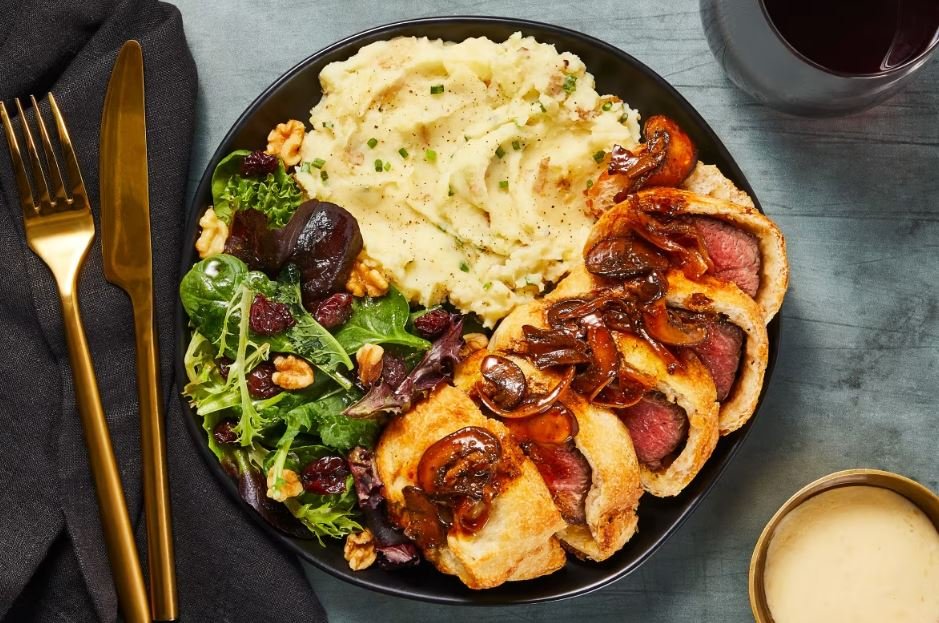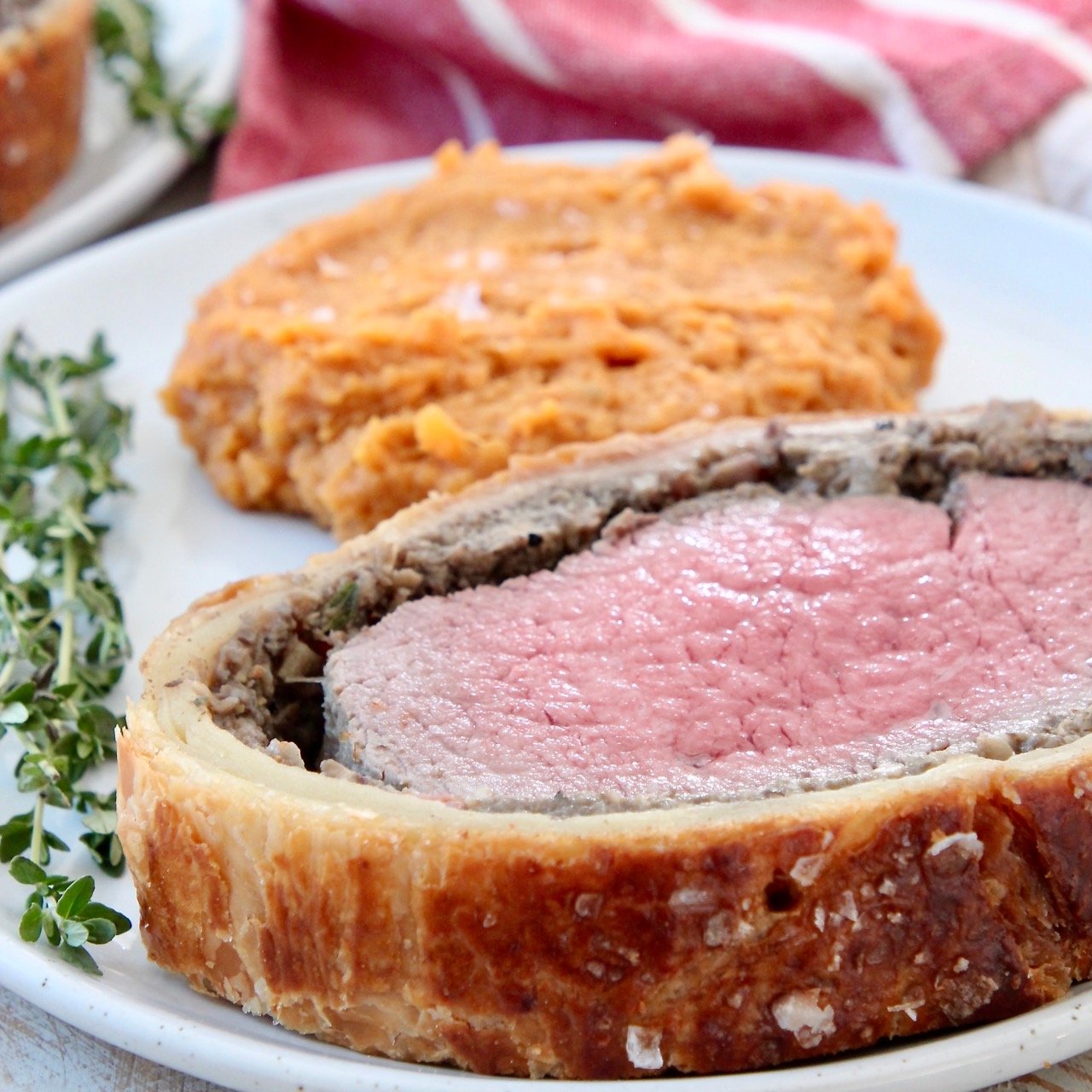Beef Wellington

Cooking Beef Wellington is a culinary adventure that you and I can enjoy together. This classic dish, renowned for its elegance, combines tender beef, savory mushroom duxelles, and crisp puff pastry. When you and I embark on this cooking journey, we’ll transform simple ingredients into a gourmet masterpiece. Let’s roll up our sleeves, dive into this delicious endeavor, and create a Beef Wellington that’s sure to impress everyone at the table. Get ready to savor every bite of this delightful recipe!


Beef Wellington
Ingredients
Equipment
Method
- Preparing the Beef: # Season the beef tenderloins generously with salt and pepper.# Heat olive oil in a large skillet over medium-high heat. Sear the beef on all sides until browned, about 2-3 minutes per side.# Remove from heat and brush each tenderloin with Dijon mustard. Let cool.
- Making the Duxelles:# In the same skillet, melt the butter over medium heat.# Add the chopped mushrooms, shallots, and garlic. Cook until the mixture is soft and the liquid has evaporated, about 10-15 minutes.# Stir in the white wine and cook until the liquid has evaporated. Season with salt and pepper to taste. Let cool.
- Assembling the Beef Wellington:# Lay out a large piece of plastic wrap on a clean surface.# Arrange half of the prosciutto slices in a rectangle, overlapping slightly, on the plastic wrap.# Spread half of the duxelles mixture over the prosciutto.# Place one of the beef tenderloins on top of the duxelles.# Use the plastic wrap to help roll the prosciutto around the beef, forming a tight log. Twist the ends of the plastic wrap to secure. Repeat with the second tenderloin.# Refrigerate for at least 30 minutes.
- Wrap in Puff Pastry:# Preheat your oven to 400°F (200°C).# On a lightly floured surface, roll out one sheet of puff pastry to a size that will completely enclose the beef tenderloin.# Unwrap the beef from the plastic wrap and place it in the center of the pastry.# Fold the pastry over the beef, sealing the edges with a bit of water. Trim any excess pastry.# Place seam-side down on a baking sheet lined with parchment paper. Repeat with the second tenderloin.
- Egg Wash:# Beat the eggs with 2 tbsp of water to create an egg wash.# Brush the puff pastry with the egg wash.
- Baking the Beef Wellington:# Bake the Wellingtons in the preheated oven for 45-50 minutes, or until the pastry is golden brown and the internal temperature of the beef reaches 130°F (54°C) for medium-rare.# Let the Wellingtons rest for 10 minutes before slicing.
The Allure of Beef Wellington
Ah, Beef Wellington! Just the name conjures up images of elegance and culinary prowess. I remember the first time I attempted this dish; it felt like embarking on a gastronomic adventure. Beef Wellington is a dish that commands attention and delivers satisfaction with every bite. But let’s dive deeper into what makes this dish truly special.
A Historical Glimpse
Did you know that Beef Wellington has roots tracing back to the 19th century? Named after Arthur Wellesley, the 1st Duke of Wellington, this dish has stood the test of time, evolving from a symbol of luxury to a beloved classic in modern kitchens.
Choosing the Right Cut of Beef
The star of this dish is undoubtedly the filet mignon. Its tender, succulent texture makes it the ideal choice for Beef Wellington. However, if you’re feeling adventurous, you might try using a chateaubriand or a tenderloin. Each cut offers its unique flair, but the melt-in-your-mouth quality of filet mignon is hard to beat.
Preparing the Beef
Seasoning is where the magic begins. A generous sprinkle of salt and pepper on all sides of the beef can work wonders. I’ve found that searing the beef until it’s beautifully browned and crusty on the outside locks in those precious juices, ensuring a succulent result.
The Magic of Duxelles
Duxelles, a finely chopped mixture of mushrooms, shallots, and herbs sautéed in butter, adds a rich, earthy flavor to the dish. Creating the perfect duxelles involves patience and a keen eye, ensuring the mixture is dry enough to prevent sogginess but moist enough to pack a flavor punch.
Adding a Layer of Luxury: Prosciutto
Prosciutto isn’t just a fancy addition; it plays a crucial role in keeping the moisture in and the puff pastry crisp. When wrapping the beef in prosciutto, ensure there are no gaps. This step is vital in achieving that perfect outer layer of pastry.
The Mustard Touch
Mustard acts as a flavor enhancer, adding a subtle zing that complements the richness of the beef and mushrooms. Dijon is my go-to choice, but don’t shy away from experimenting with whole grain or spicy mustards for a unique twist.
Wrapping in Puff Pastry
Choosing a high-quality puff pastry can make all the difference. Look for one with lots of layers and butter. Wrapping it snugly around the beef, making sure there are no tears, is essential to avoid any leaks during baking.
Chilling for Success
After wrapping, chilling the Beef Wellington is crucial. This step helps the pastry firm up, ensuring it stays intact during baking. I usually chill mine for at least 30 minutes, but an hour is even better if you have the time.
Baking to Perfection
Preheat your oven to ensure even cooking. I bake my Beef Wellington at 400°F (200°C) for about 25-30 minutes for a medium-rare finish. Remember, it’s important to let it rest after baking to allow the juices to redistribute, resulting in a perfectly moist slice.
Creating a Stunning Presentation
Presentation is half the battle won. Slice the Beef Wellington with a sharp knife, revealing the beautiful layers within. Arrange on a platter and garnish with fresh herbs or edible flowers for an extra touch of elegance.
Pairing with Sides
Classic sides like roasted potatoes and green beans are always a hit. However, for a modern twist, I love serving it with truffle mashed potatoes or a vibrant beet and goat cheese salad. The contrast in flavors and colors makes the dish even more enticing.
Sauce Pairings
A rich, velvety sauce elevates the Beef Wellington to new heights. Traditional choices like a red wine reduction or a creamy mushroom sauce are fantastic. For something different, try a tangy balsamic glaze or a sweet port sauce.
Wine Pairings
A robust red wine like a Cabernet Sauvignon or a Pinot Noir pairs wonderfully with Beef Wellington. For those who prefer non-alcoholic options, a rich, full-bodied grape juice or a sparkling water with a twist of lime works beautifully.
Tips for a Perfect Beef Wellington
Avoid common pitfalls like overcooking the beef or undercooking the pastry. Use a meat thermometer to ensure the internal temperature is just right. Also, don’t rush the resting process; it’s essential for a juicy result.
Variations on the Classic
Mini Beef Wellingtons are perfect for parties, offering the same flavors in a bite-sized package. For vegetarians, a Wellington made with portobello mushrooms and lentils is a hearty alternative. Vegan versions can use a mix of vegetables and plant-based puff pastry.
Making Ahead and Storing
You can prepare the Beef Wellington up to the chilling stage a day in advance. Store it in the fridge and bake just before serving. Leftovers, if any, can be stored in an airtight container and reheated gently to maintain the pastry’s crispiness.
Serving Suggestions
Timing is key. Serve the Beef Wellington hot, ideally within 10 minutes of slicing. Portioning can be tricky; I find slicing it into 1-inch thick pieces offers a perfect balance of meat and pastry in each bite.
Themed Dinner Ideas
Why not create an entire Wellington-themed dinner party? Start with mini Beef Wellingtons as appetizers, followed by the main dish, and end with a dessert Wellington filled with berries and cream. Plan a menu that complements the richness of the Beef Wellington for a truly memorable evening.
A Journey Through Beef Wellington Globally
Different cultures have their versions of Beef Wellington. In France, you might find a Wellington with foie gras, while in Japan, they might use wagyu beef. Exploring these variations can be a delightful culinary journey.
Personal Reflections and Memories
My first attempt at Beef Wellington was a rollercoaster of emotions. From the nervousness of searing the beef just right to the triumph of slicing into a perfectly baked pastry, it was a culinary milestone. Over the years, this dish has become a symbol of celebration and cherished memories in my home.
Ah, the journey of crafting Beef Wellington is as rewarding as the final dish itself. Whether you’re a seasoned cook or a curious beginner, this dish promises to be an unforgettable experience. Happy cooking!
FAQs
1. What is Beef Wellington?
Beef Wellington is a classic British dish consisting of a beef tenderloin coated with a mushroom duxelles, wrapped in prosciutto and puff pastry, and then baked to a golden perfection.
2. Why is it called Beef Wellington?
The origins of the name are debated. Some say it was named after the Duke of Wellington, while others believe it was inspired by the Wellington Boot due to its resemblance in shape.
3. What cut of beef is used in Beef Wellington?
Beef Wellington typically uses a beef tenderloin (also known as filet mignon), which is prized for its tenderness and mild flavor.
4. What is duxelles?
Duxelles is a finely chopped mixture of mushrooms, onions, shallots, and herbs sautéed in butter. It adds a deep, earthy flavor to the dish.
5. Can I prepare Beef Wellington in advance?
Yes, you can assemble the Beef Wellington up to 24 hours in advance and store it in the refrigerator. Bake it just before serving for the best results.
6. What temperature should Beef Wellington be cooked to?
For a medium-rare finish, aim for an internal temperature of 125-130°F (51-54°C) after resting. The pastry should be golden brown and crisp.
7. What sides go well with Beef Wellington?
Popular sides include roasted vegetables, mashed potatoes, asparagus, and a rich red wine or Madeira sauce.
8. Is there a vegetarian version of Beef Wellington?
Yes, a vegetarian version can be made using a hearty vegetable filling, such as portobello mushrooms or a mix of root vegetables, wrapped in puff pastry.
9. How do you keep the pastry from getting soggy?
To prevent soggy pastry, make sure the duxelles and prosciutto layer are dry before wrapping, and ensure the beef is well-sealed in the pastry. Chilling the assembled Wellington before baking also helps.
10. Can Beef Wellington be frozen?
Yes, Beef Wellington can be frozen before baking. Wrap it tightly in plastic wrap and foil, then freeze. When ready to cook, bake from frozen, adding extra time to ensure it cooks through.
